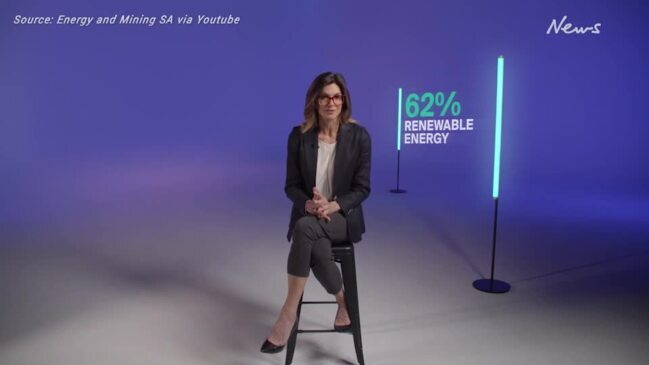Green hydrogen future set to revive South Australia’s rusty Iron Triangle: Whyalla, Port Pirie and Port Augusta
The future of what was once our most significant industrial area has been uncertain for decades. Now, that’s set to change.

SA News
Don't miss out on the headlines from SA News. Followed categories will be added to My News.
A unique convergence of political will, climate, electricity-hungry established industry and abundant resources may not only save South Australia’s most significant and productive industrial area but allow it to thrive again on the global stage.
For decades in decline and with an uncertain future as a region, Australia’s rusty Iron Triangle may well be known by future generations as the thriving Hydrogen Triangle.
With the Port Augusta power station closing in 2016, lead and steel production struggling, and ship building long gone, the region’s best days seemed to have passed it by.
But the state government and the private sector again have big plans for the triangle formed by Whyalla, Port Pirie and Port Augusta.
Hydrogen has been a buzzword in government since the first plans were made to develop the industry in SA in 2017. It has been slowly developing as a source of reliable green electricity to produce green products such as steel and green liquefied gas exports to fuel the world’s thirst for a low carbon future.
With the election of the Labor state government in March, a $593m injection of taxpayer funds will accelerate the state’s hydrogen future.
What does this mean for SA? A taxpayer-funded hydrogen-fired power plant, an electrolyser to produce the hydrogen, a storage facility to store hydrogen liquid pressurised from the gas, and a thriving hydrogen export industry.

South Australia’s newest export product will be especially valuable as “green hydrogen” will be produced from zero-carbon wind and solar electricity splitting the H2O water molecules into hydrogen and oxygen.
Exports for green hydrogen are increasing in demand as countries including China, Korea, Japan and Singapore move away from the rival liquefied nature gas.
By 2030, 100 per cent of SA’s power will be supplied by renewables.
Domestically hydrogen electricity generation will ease some of the problems with the state’s electricity supply reliability.
Although a renewable success story during the death of coal, SA’s solar and wind produce power out of sync with demand. Inability to store large quantities adds another complexity.
Hydrogen gas-produced electricity can bridge the divide by taking control of production away from variations in sun and weather, and with the fuel able to be easily stored.
But ironically the abundant cheaper solar and wind electricity generation around the Iron Triangle is also the key ingredient for hydrogen’s success, providing the green power to greenly produce hydrogen from water molecules.
Energy Minister Tom Koutsantonis last month began the early planning stages of the centrepiece of the state government’s infrastructure plan.
The previous Liberal Party government advocated a $13bn private sector backed hydrogen hub at Port Bonython north of Whyalla.
Mr Koutsantonis has other ideas, a huge taxpayer fillip of $593m to get the hydrogen ball rolling.
Work has already begun planning the taxpayer project, with construction between 2023 and 2025. It is headed by $500,000-a-year hydrogen tsar Sam Crafter, son of Labor Party stalwart and former Bannon government minister Greg Crafter.

Mr Crafter heads the Office of Hydrogen Power within Mr Koutsantonis’s Department for Energy and Mining.
The office will remain under the minister’s tight control and as per Labor’s anti-privatisation stance, ownership of the asset will remain in taxpayers’ hands.
The government’s Hydrogen Power South Australia will then operate as a business at arm’s length, producing the product but also facilitating billions in private sector development.
green hydrogen supply chain.
Mr Koutsantonis said one of the first priorities was consultation with Indigenous and environmental groups, especially as the region is home to SA’s world renowned giant cuttlefish breeding grounds.
One thing Mr Koutsantonis and the Liberals can agree on is major interest in the region from significant companies; Fortescue Future Industries, Origin Energy, Santos and H2U, as well as global companies Eneos, Chiyoda, Mitsubishi and AMP Energy.
All were short-listed by the former government to access $140m in government and private funding to set up a non-government plant.
Already a key piece of the private sector hydrogen puzzle is falling into place. Hydrogen opportunities will be amplified by the willingness of industry to use it in creating green products.
The state government, with smelter operator Nyrstar, is also helping with seed funding for the Port Pirie Green Hydrogen Project.

A decision will be made at the end of this year about whether smelter Nyrstar will go ahead with a privately backed $750m hydrogen and ammonia plant. It would provide 20 per cent of the Port Pirie green metals recovery operations.
It is value adding from simple hydrogen production that excites people like Regional Development Australia Eyre Peninsula chief executive Ryan Viney.
“To obtain maximum ongoing benefit for the region, long after these (infrastructure) facilities have been commissioned, it is going to be critical to develop local supply chains and build skills, knowledge and capacity within the region,” he said.
Port Augusta Mayor Brett Benbow is thinking of more immediate benefits, with the city well removed from the likely Whyalla base of most operations.
He said the most immediate effect for the city would be for contractors during the construction phase of the public sector project. Region-wide, 11,000 jobs are likely to be created in the region.


Mayor of Port Pirie Leon Stephens said the Iron Triangle fully appreciated the region-wide potential of the government commitment.
Mayor Stephens is also chair of the Upper Spencer Gulf Cities group and said the prospects were exciting for the entire region.
“The projects in Whyalla I think will bring that city back to the days of ship building with jobs and investment,’’ he said.
“In Port Pirie it is also a great opportunity and probably the way of the future. It has flowed into each other, the solar development, the wind farms and now green hydrogen on the back of that.”
Whyalla Mayor Clare McLaughlin last week hosted representatives of about a dozen companies to gauge the potential of the city to meet demands.
She said the council had for two years been keen to help decarbonisation of local heavy industry and the global transition to a low-carbon.
“This is a really positive outcome for Whyalla (state government investment) and the future diversity of our economy,’’ Ms McLaughlin said.
“We can only see growth happening because of hydrogen.”




